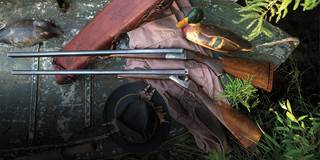Shotgunning: Famous Foxes
These legendary shotguns evoke the spirit of waterfowling in the early 20th century
These legendary shotguns evoke the spirit of waterfowling in the early 20th century
Ansley H. Fox called his shotgun "the finest gun in the world." Theodore Roosevelt agreed that "no finer gun was ever made." After legendary outdoor writer Nash Buckingham tried a Fox, he sold his Parker. "Finest in the world" might be a stretch, but A.H. Fox guns stand with the best classic American doubles.
A born inventor and talented trapshooter, Fox was a veteran of a couple of false starts in the gun business when he founded the A.H. Fox Company in Philadelphia in 1906. Built on a simple, strong action that Fox himself designed, Fox shotguns didn't wear out or break. They were also good-looking, with distinctive, elegantly sculpted frames. The company remained in Philadelphia until 1929, when it was bought by Savage, which continued making original Fox guns in Utica, New York, until 1946, although Fox fanciers believe the Philadelphia guns to be the best.
The most famous Fox belonged to Nash Buckingham. The story begins with John Olin of the Western Cartridge Company, which introduced Super X shotshells in 1921. Loaded with hard, copper-plated shot, the new ammunition promised real improvements for long-range duck loads. Testing the new ammunition, Olin found the best performance came from an A.H. Fox double-bored by Philadelphia gunsmith Burt Becker. Olin sent the gun and eight boxes of the new shells to Buckingham to try on high ducks and geese. Impressed, Buckingham ordered a Fox of his own.
Meanwhile, Becker, gun writer Charles Askins Sr., and Fox collaborated on a new shotgun to shoot the Western shells. Introduced in early 1923, the 3-inch Super Fox weighed over nine pounds and featured a beefed-up frame, lengthened forcing cones, extra-full chokes, and long, overbored barrels. The gun embodied Buckingham's famous adage: "Never send a boy on a man's errand." Buckingham ordered a Super Fox with a straight grip stock, no safety, and extra engraving. It earned the name "Bo Whoop" for its distinctive two-note report. In Buckingham's hands it was deadly.
Buckingham shot Bo Whoop for over 20 years, immortalizing it in his stories until December 1, 1948, when two game wardens checked Buckingham and his friend Clifford Green for their licenses, then asked if they could see the famous gun. Afterward, Green and Buckingham drove away with Bo Whoop still on the fender of Green's car and never saw the gun again.

Photo Terry Allen
If you're a fan of Buckingham and his famous Fox, it's possible to find a similar gun for yourself. About 300 Super Foxes were built, mostly 12-gauges and a few 20-gauges. They sell in the $8,000 to $10,000 range and do occasionally come up for sale. Most show signs of serious use. A more affordable option is the Fox Sterlingworth, the entry-level Fox double made from 1910 to 1942. It's a rugged gun you can find for $1,100 to $1,600. A few of those Sterlingworths were 3-inch Wildfowl Grades.
The Fox Model B, sold by Savage from 1940 to 1986, was a Fox in name only, but it was a solid double that you can buy now for $400 to $600. The Connecticut Shotgun Manufacturing Company (CSMC) now builds the Fox A Grade for Savage. The gun has Fox lines and engraving and a price of $4,105. CSMC also builds beautiful high-grade Foxes starting around $20,000. If Ansley Fox were alive today, he would recognize them immediately, and might very well call them some of the finest guns in the world.
Ducks Unlimited uses cookies to enhance your browsing experience, optimize site functionality, analyze traffic, and deliver personalized advertising through third parties. By continuing to use this site, you agree to our use of cookies. View Privacy Policy